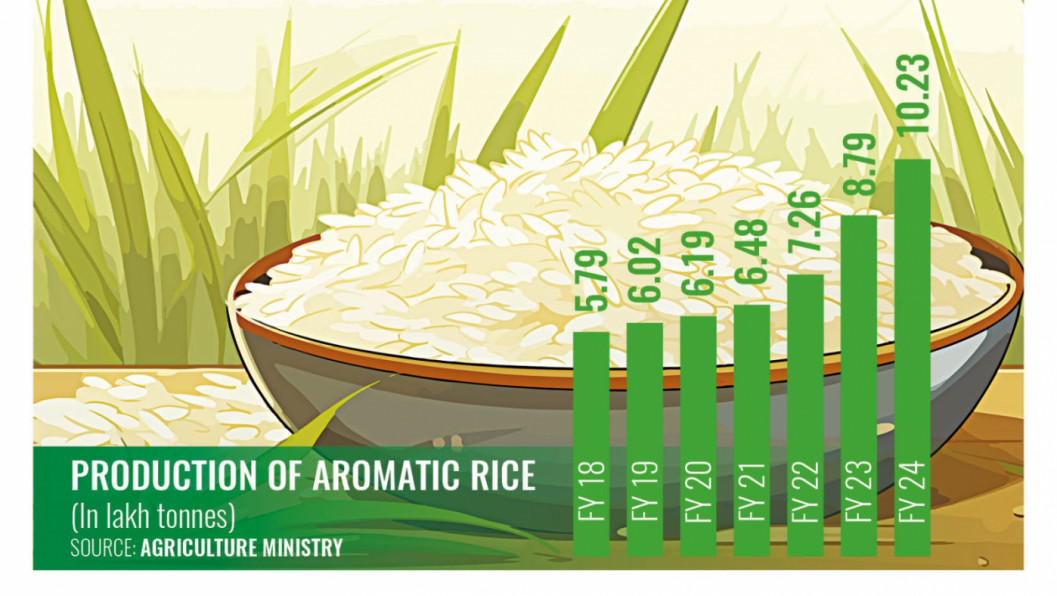Over the last seven years, Bangladesh’s production of aromatic rice has almost doubled, and farmers are eager to cultivate the grain to benefit from its higher prices than those of conventional parboiled rice. According to a document from the food ministry, farmers produced 5.79 lakh tonnes of aromatic rice in the 2017–18 fiscal year and 10.23 lakh tons in the 2023–24 fiscal year.
Exports are the primary driver of increased cultivation, according to Mohammad Khalequzzaman, director general of the Bangladesh Rice Research Institute (BRRI).
A few years ago, the government permitted the export of rice of superior quality. Many farmers consequently concentrated on growing aromatic rice, which resulted in a notable increase in output, he continued.
Khalequzzaman added that the fact that aromatic rice produces higher yields and tastes better than regional varieties is another factor driving the growth of aromatic rice production.
Aromatic rice is grown throughout the nation’s districts, and depending on the area, the same kind is frequently called by several names. The Aman season is when this variety of rice is cultivated.
33 varieties of fragrant rice are presently grown in Bangladesh, according to BRRI data. According to a food ministry official, farmers have been encouraged to increase production in recent years by the growing demand for fragrant rice in both domestic and foreign markets as well as by the lucrative rates for this product.
As a result, farmers are switching to crops that give double the yield and greater profitability, overshadowing traditional indigenous types. High-yielding varieties can yield between 448 and 821 kilos of rice per bigha, but local types usually yield between 187 and 299 kilograms.
According to the Department of Agricultural Extension (DAE), the land and climate of the nation are ideal for growing aromatic rice. Bangladesh’s principal centers for the commercial production of fragrant rice are Naogaon, Rajshahi, Panchagarh, Rangpur, Mymensingh, Dinajpur, Sherpur, and Thakurgaon.
According to a different food ministry official, the country’s population’s improved socioeconomic circumstances are driving up demand for aromatic rice. The output of fragrant rice has nearly doubled in recent years as a result of farmers being drawn to crops that offer competitive prices.
Additionally, the market for aromatic rice has seen the entry of large corporate organizations. The official also noted that although output has increased quickly, consumer demand has not kept up, leading many traders to call on the government to ease export restrictions.
Additionally, he claimed that farmers would not benefit from the mere Tk 10 per kilogramme price difference between aromatic rice and premium parboiled rice.
Therefore, he added, allowing limited exports could help farmers by giving them larger profits. However, representatives of the Food Planning and Monitoring Unit have issued a warning about the possible drawbacks of exporting.
One pointed out that a rise in the production of aromatic rice could result in a decrease in the production of coarse rice, which would have a detrimental effect on the nation’s basic food supply as the amount of agricultural land available is decreasing. “Therefore, a careful balance must be maintained,” he stated.
“We are currently importing a significant amount of rice; now is not the right time to export aromatic rice,” stated Ali Imam Majumder, the food adviser. “The highest levels of government would need to approve limiting exports if doing so would help farmers. But as of yet, there has been no sign of such a decision,” he continued.
AROMATIC RICE EXPORT
Export revenue from aromatic rice was $2.88 million in the 2019–20 fiscal year and then dropped to $2.06 million the following year, according to data from the Export Promotion Bureau (EPB).
Aromatic rice exports totaled $1.07 million in fiscal year 2021–2022, but due to a prohibition, shipments were suspended in fiscal year 2022–2023. Additionally, according to the EPB data, as of December of the fiscal year 2024–2025, no aromatic rice had been shipped.
IMPORTS OF AROMATIC RICE WERE CUT IN TWO YEARS
In fiscal years 2023–2024 and 2024–2025, Bangladesh imported no aromatic rice, according to a food ministry document. But according to the report, imports came to 2.61 tonnes in fiscal year 2022–2023; 37.76 tonnes in fiscal year 2021–2022; and 54.14 tonnes in fiscal year 2020–2021.
IMPORTS OF LONG-GRAIN BASMATI RICE DECLINE
According to the food ministry statement, imports of long-grain basmati rice increased from 1,891 tonnes in the fiscal year 2020–21 to 6,334 tonnes in the subsequent fiscal year.
In fiscal year 2022–2023, the amount rose to 7,712 tonnes. But in fiscal year 2023–2024 imports fell to 4,615 tonnes, and in fiscal year 2024–2025 they fell to just 799 tonnes.
Source: The Daily Star















